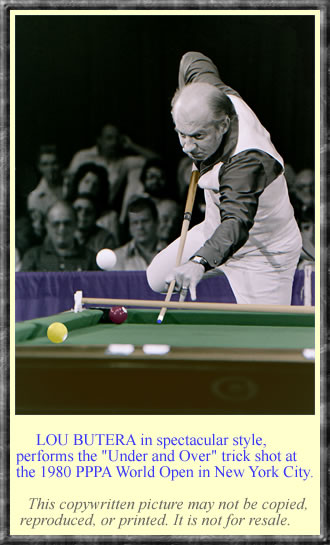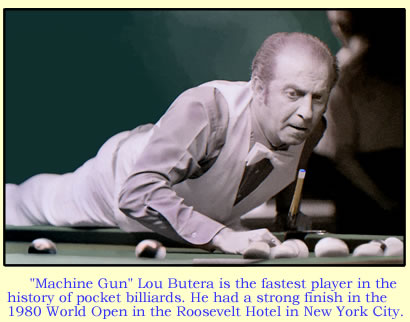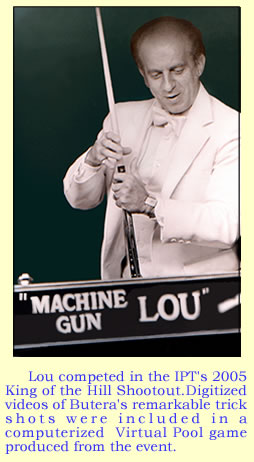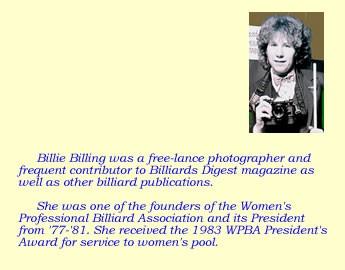.....When I was learning how to play
pool there were no books, no videos, no instructors and no leagues
to play in. The best way to learn was to watch. I was privileged
to see some of the greatest and some of the not so great. My
purpose for publishing my pointers insrtuctional column is not
only to inpart pool knowledge to my viewers but to share with the
public what these great players from the 1980s and 1990s looked
like. Through my trusty Canon, for a moment in time they are immortalized.
Some are still here and some are gone and I still remember the
joy of watching them play.

NO OBSTACLE TOO GREAT
.
The "Under and Over" shot, perfected by
Lou Butera, involves obstacles not normally
found during the course of a game.
Still, there is a lesson to be learned.

.....SOMETIMES TRICK SHOTS can be hugely instructive. Not only is the “Under and Over the Bridge” shot one of my favorites, it is also one of the most difficult shots to make and continues my discussion about draw from last month’s column. “Machine Gun” Lou Butera, one of pool’s most colorful entertainers, uses this shot with great success in his exhibitions. Here, I captured Lou performing the stunt at the World Open in New York.

.....Lou was born 1937 in Pittston, Pennsylvania and is an American professional pool player who is now retired and operating a pool hall. He was inducted into the Billiards Congress of America's Hall of Fame in 1986. His nickname, "Machine Gun Lou", derives from his stunning the crowd and fellow competitors by running 150-and-out in straight pool in 21 minutes against Allen Hopkins in 1973. But, dear reader, I digress…
.....You begin by placing the mechanical bridge, with the flat side down, across the long rails near the first diamond. Depending on the type of mechanical bridge you are using, sometimes the player needs to prop up the end handle of the bridge by placing a piece of chalk under it on the opposite side of the table to give the bridge more or ‘even’ height.

.....Place one object ball (in this case, it’s the 1 ball) about a ball’s width below the bridge and towards the foot of the table. Place another object ball (Lou used the
7 ball) in the jaws of the corner pocket. Right handers should use the right side of the table and vice versa for left handers. The cue ball should be placed a few inches behind the 1 ball, aiming to sink it in the top corner pocket. Make sure the cue ball is placed close enough to the bottom rail so that you can make your hand bridge on top of the rail as you can see Lou doing in the photograph. With your cue stick elevated about 30 degrees, strike down on the cue ball sharply, below the vertical axis.
.....The cue ball is, essentially, already on its way into the air and strikes the top of the 1 ball sending it into the corner pocket. Notice that Butera strikes the cue ball so hard his stick actually bends slightly after he completes his stroke. Then the cue ball flies over the bridge, returns to the table and draws backward to sink the 7 ball in the lower corner pocket.
.....This shot, while vastly artistic, illustrates exaggerated use of draw. If you are not getting enough drawback on your shot, elevate your cue a little more. As always, the secret to success is to practice, practice, practice.
 . .

.....Pool Pointer Archives
.....1. Closed Half-Bridge
... .2. Look Before You Leap
.....3. Mechanically Inclined
.....4. Keep A Level Cue
.....5. Double or Nothing
.....6. Chalk It Up
.....7. V-Bridge It To Victory
.....8. The Right Combination
.....9. Referees; Unsung heros
...10. Don't Lag Behind
...11. Tongue Twister; Mouth Pool
...12. Read The Right Angle
...13. Don't Let Your Draw Stroke Be a Drawback
...14. Under and Over With Lou Butera
.....Tune
in for more Pointer articles coming
your way each month.

|

